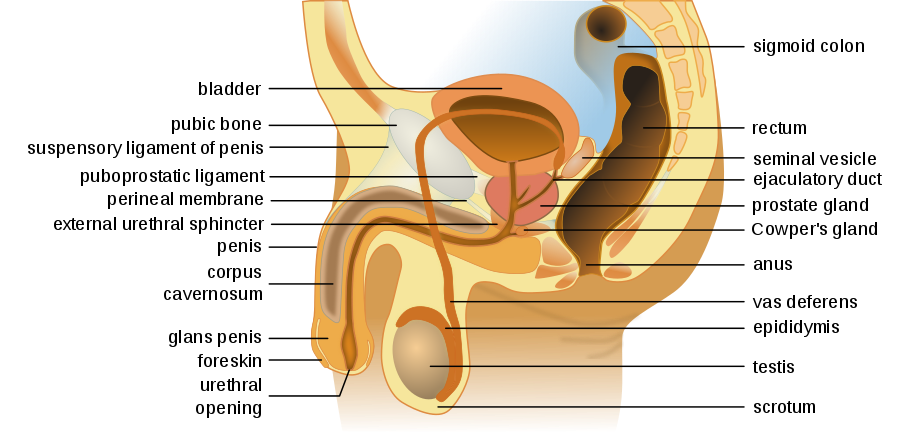
(a) Draw a well labelled diagrammatic view of the human male reproductive system.
(b) Differentiate between:
(i) Vas deferens and vasa efferentia
(ii) Spermatogenesis and spermiogenesis
Answer
557.1k+ views
Hint: The male reproductive unit consists of penis, a pair of testes and scrotum. These structures are essentially located outside the body as for sperm production temperature required is generally lower than our body temperature.
Complete answer:
(a) Labelled diagram of human male reproductive system-

(b)
(i) Difference between Vas deferens and vasa efferentia
(ii) Difference between spermatozoa and spermiogenesis
Note: Spermatogenesis is the process by which the production of sperms from the immature germ cells takes place in males. It occurs in seminiferous tubules present inside the testes. At the time of spermatogenesis, a diploid spermatogonium (which is a male germ cell) gets increased in its size to form a diploid primary spermatocyte. This diploid primary spermatocyte further undergoes first meiotic division (i.e. meiosis I), which is also known as reductional division in order to give rise to two equal haploid secondary spermatocytes. Each secondary spermatocyte then further undergoes a second meiotic division (i.e. meiosis II) to give rise to two equal haploid spermatids. As a result, a diploid spermatogonium produces four haploid spermatids. These spermatids get transformed into spermatozoa (sperm) by the process called spermiogenesis.
Complete answer:
(a) Labelled diagram of human male reproductive system-

(b)
(i) Difference between Vas deferens and vasa efferentia
| Vas deferens | Vasa efferentia |
| • Arise from epididymis. | • Arises from rete testes. |
| • It is a very thick and coiled tube. | • It is a fine and a convoluted tubule. |
| • Two in number. | • They are 15-20 in number |
| • Transport spermatozoa from epididymis to ducts. | • Transport spermatozoa from rete from testes to epididymis. |
(ii) Difference between spermatozoa and spermiogenesis
| Spermatozoa | Spermiogenesis |
| • It is the process of formation of haploid spermatozoa from undifferentiated diploid germ cells. | • It is the process in which transformation of haploid spermatids occurs into mature sperms. |
| • It includes multiplication, growth, maturation and differentiation phase. | • It Includes only differentiation. |
| • One spermatogonia gives rise to four sperms. | • One spermatid gives rise to one sperm. |
Note: Spermatogenesis is the process by which the production of sperms from the immature germ cells takes place in males. It occurs in seminiferous tubules present inside the testes. At the time of spermatogenesis, a diploid spermatogonium (which is a male germ cell) gets increased in its size to form a diploid primary spermatocyte. This diploid primary spermatocyte further undergoes first meiotic division (i.e. meiosis I), which is also known as reductional division in order to give rise to two equal haploid secondary spermatocytes. Each secondary spermatocyte then further undergoes a second meiotic division (i.e. meiosis II) to give rise to two equal haploid spermatids. As a result, a diploid spermatogonium produces four haploid spermatids. These spermatids get transformed into spermatozoa (sperm) by the process called spermiogenesis.
Recently Updated Pages
A man running at a speed 5 ms is viewed in the side class 12 physics CBSE

State and explain Hardy Weinbergs Principle class 12 biology CBSE

Which of the following statements is wrong a Amnion class 12 biology CBSE

Two Planoconcave lenses 1 and 2 of glass of refractive class 12 physics CBSE

The compound 2 methyl 2 butene on reaction with NaIO4 class 12 chemistry CBSE

Bacterial cell wall is made up of A Cellulose B Hemicellulose class 12 biology CBSE

Trending doubts
What are the major means of transport Explain each class 12 social science CBSE

Which are the Top 10 Largest Countries of the World?

Draw a labelled sketch of the human eye class 12 physics CBSE

Explain sex determination in humans with line diag class 12 biology CBSE

Give 10 examples of unisexual and bisexual flowers

State the principle of an ac generator and explain class 12 physics CBSE




